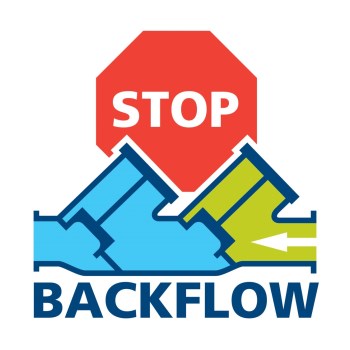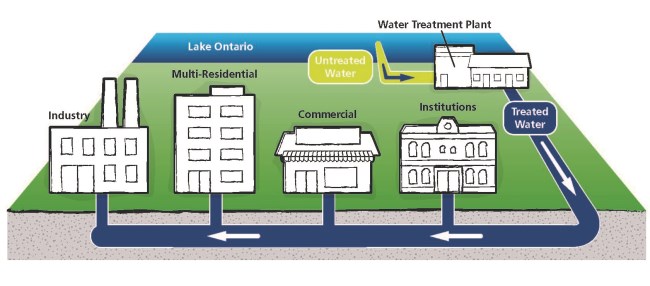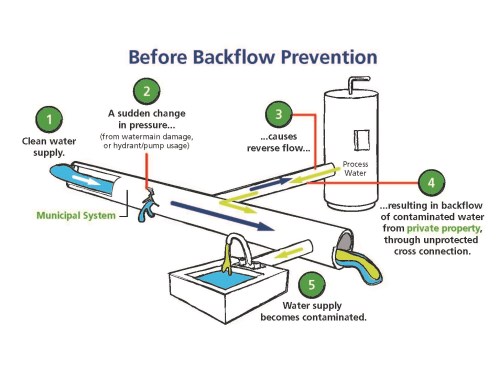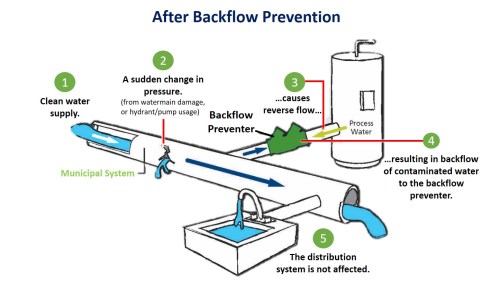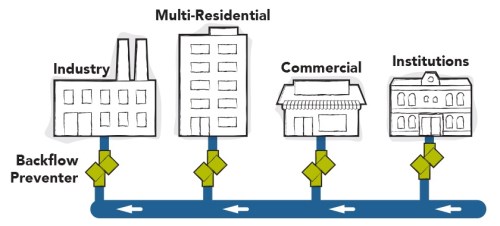| Is this program related to basement flooding and installation of backwater valves on sewer lines? |
| No. The Town’s Backflow Prevention Program deals with protecting our drinking water. This program is not to be confused with backwater valves that are placed on sewer lines to prevent basement flooding. |
| Why is a Backflow Prevention Program (BFPP) Needed? |
| The Town's Backflow Prevention program is developed under bylaw 5645-14 to protect the health and prevent possible drinking water contamination from unprotected Cross Connections. The program is necessary to meet the requirement of the Safe Drinking Water Act, 2002, the Ontario Building Code (OBC) and the Canadian Standards Association (CSA) B64. The BFPP and Bylaw are aligned with the Town's Drinking Water Quality Management System to provide safe drinking water to its residents and businesses. |
| What is a Cross-Connection? |
| A Cross-connection is any temporary or permanent connection between a municipal drinking water system and any source or system containing non-potable water or other pollutants. Examples of cross connections are the connection between a public water system and a heating/ cooling system, or a fire system, or an irrigation system, etc.
Cross connections pose a hazard to the drinking water system if backflow occurs and contaminated water from a building is drawn back into the drinking water system.
A connection is any temporary or permanent connection between a municipal drinking water system and any source or system containing non-potable water or other pollutants. Examples of cross connections are the connection between a public water system and a heating/ cooling system, or a fire system, or an irrigation system, etc.
Cross connections pose a hazard to the drinking water system if backflow occurs and contaminated water from a building is drawn back into the drinking water system.
|
| What is Backflow? |
| Backflow is defined as the undesired reversal of drinking water flow within a plumbing system. When flow reversal occurs, there is a potential to draw water and potentially pollutants into the drinking water piping and ultimately the Town’s drinking water distribution system. This results in unsafe conditions at the property, Town’s drinking water system and neighbouring properties. |
| What Causes Backflow? |
|
Backflow can happen because of backpressure or back siphonage.
Backpressure: Occurs when the pressure within a building’s plumbing system is greater than the pressure in the drinking water system. This results in the water within that building being forced backward and into the Town’s drinking water system. These situations can occur at high rise buildings as a result of increasing pressures to pump water to the upper floors or at industrial buildings from pumps within the processes.
Back Siphonage: Occurs when the pressure in the drinking water system is decreased due to a watermain break, hydrant flushing operations or firefighting operations.
|
| How often does backflow and contamination of the drinking water system happen? |
| The opportunity for backflow occurs whenever there is a large difference in pressure between the private system and the Town's drinking water system. The occurrence of major pollutants entering the drinking water system is less frequent but can happen at any time when there is backpressure or back siphonage and no backflow prevention device is installed. |
| What properties does the Backflow Prevention Program apply to? |
| This program applies to existing and new industrial, commercial, institutional, as well as mixed-use and multi-residential buildings. It also applies to any property that poses a risk to the quality of the Town's drinking water and safety of our community, regardless of property class. |
| How does this program apply to Townhouses? |
| This program does not apply to townhouses where there are individual water services to each townhouse from the Town’s drinking water system. However, in cases where there is a single water service line from the Town’s drinking water system for the entire subdivision, backflow prevention will be required. |
| Would any buildings be exempt or grand-parented under the program? |
| There will be no exemptions or grand-parenting. |
| What is the definition of a Multi-Residential Building? |
| A “multi-residential building" means a residential building that consists of more than six (6) self- contained residential dwelling units, but does not include buildings that only consist of residential single- dwelling units that are solely attached to other residential units on the sidewall (such as semi-detached homes, townhomes or row houses) or single-dwellings that contain basement apartments or annexes. |
| Who is responsible for meeting he BFPP requirements? |
|
The owner of the property or agent of the owner.
|
| What are my responsibilities to comply with the Backflow prevention bylaw? |
|
The owner of the property or agent of the owner must ensure that the following activities are performed, and reports submitted to the Town within the timelines indicated in the by-law:
- Undertake a Cross Connection Control Survey for each service connection at every property you are responsible for and submit the signed Survey Report to the Town. These are required every 5 years or when there is a change in ownership or property use.
- Obtain a permit and install Backflow Preventer on each service connection.
- Test Backflow Preventer(s) upon installation, repair, relocation or replacement and annually thereafter, and submit the signed Test Report(s) to the Town.
- Undertake corrective actions identified in Cross Connection Control Survey Report and/or the Backflow Prevention Device Test Report
- Ensure that the work is performed by qualified personnel as required under the by-law. Owners will be responsible for all costs related to backflow prevention at their properties.
|
| Will there be Administration Fees? |
| No, the Town will not charge administration fees for this program. |
| Will there be one submission date for everyone? |
| There is a deadline of spring 2020 for everyone, for the initial Cross Connection Control Surveys. However owners can choose to submit them earlier which will determine the 5-year anniversary date for submission of future surveys. The recommendations from the surveys will determine if a device is required. The device installation date would be the anniversary date when the test report would be due. |
| What are the consequences of not complying with the requirements of the Backflow prevention program? |
| Compliance will be monitored by the Town’s Operational Services. Enforcement will range from reminders and notifications to fines, penalties and disconnection of the water supply to the subject property. |
| What is a Backflow Preventer? |
| A Backflow Preventer is a mechanical device that prevents the backflow of water into the public drinking water system. The type of device required for your facility is based on the hazard level your facility is classified as. The types of Backflow Preventers used for premise isolation are: Reduced-Pressure Principle Assembly and Double Check Valve Assembly. |
| What is Premise Isolation? |
| Premise isolation is the separation of Town’s drinking water distribution system from the private plumbing system through the installation of a testable backflow prevention device downstream of the water meter. |
| Where should I install the Backflow Preventer? |
| Backflow preventers are typically installed on the water service connection, on the private side, immediately downstream of the water meter and upstream of any connections. This location must meet the requirements of the Ontario Building Code (OBC). A building permit must be obtained from the Town’s Building Services prior to installation. If you have a unique situation where the location of the backflow preventer may not meet the requirements of the OBC, we encourage you to contact Water Services to discuss your situation. |
| Will the water pressure be reduced within the private plumbing due to the installation of a premise isolation backflow preventer? |
| Yes. The installation of a backflow preventer will reduce the water pressure within your facility. Please consult with the contractor to ensure that there will be adequate water pressure for your processes after the backflow preventer is installed. |
| Is a Building permit required to install the Backflow Preventer? |
| Yes. The installation of backflow preventers must meet the requirements of the Ontario Building Code, therefore a building permit must be obtained from the Town’s Building Services prior to installation. For additional information on the building permit application please contact the Towns Building Services department. |
| Why do Backflow preventers need to be tested periodically? |
| Backflow preventers have internal parts that can wear and tear, so they must be tested periodically, by qualified persons, to ensure they are working properly. |
| Where can I obtain the required forms? |
|
The forms can be found under the Applications and Forms section on this webpage.
|
| Who is authorized to perform the work required for the Backflow Prevention Program? |
|
Only those persons with the required qualifications listed in the Authorized Functions List, attached as Schedule "A" to the by-law may carry out the corresponding functions shown. Persons performing Cross Control Surveys and Testing of Backflow Preventers must provide to the Town proof of qualification along with the following:
- a current and valid Cross-Connection Control Specialist Certificate issued by the Ontario Water Works Association (OWWA)
- a valid calibration certificate for their testing equipment
- proof of Commercial General Insurance (CGI) in good standing
Companies registered with Town’s Backflow Prevention Program can be contacted and hired by property owners to survey, install and test backflow devices. Before hiring a contractor ensure he/she has proper certification.
Note: The Town of Aurora does not endorse Qualified Companies or Qualified Persons and does not accept liability or assume responsibility for work completed by companies under this program.
|
|
How can a qualified company/qualified person register for the BFP program?
|
| If you would like to register with Town’s Backflow Prevention Program, please complete a Qualified Company & Qualified Person Registration form found under downloads on this page and submit it to us using the methods indicated on the form, along with all applicable credentials as specified. |
| What are the estimated costs to property owners? |
| The initial cost would depend on the fees charged by a qualified person to undertake the survey, install the backflow preventers and perform the tests. The backflow preventer cost would depend on the type of device recommended for installation and the location. Once the device is installed and tested, the cost to the owner would be the annual cost of testing and any required repairs. |
| Will there be incentives or rebates to property owners? |
| No. The program is mandatory to ensure that the Town’s drinking water remains safe for consumption. |
